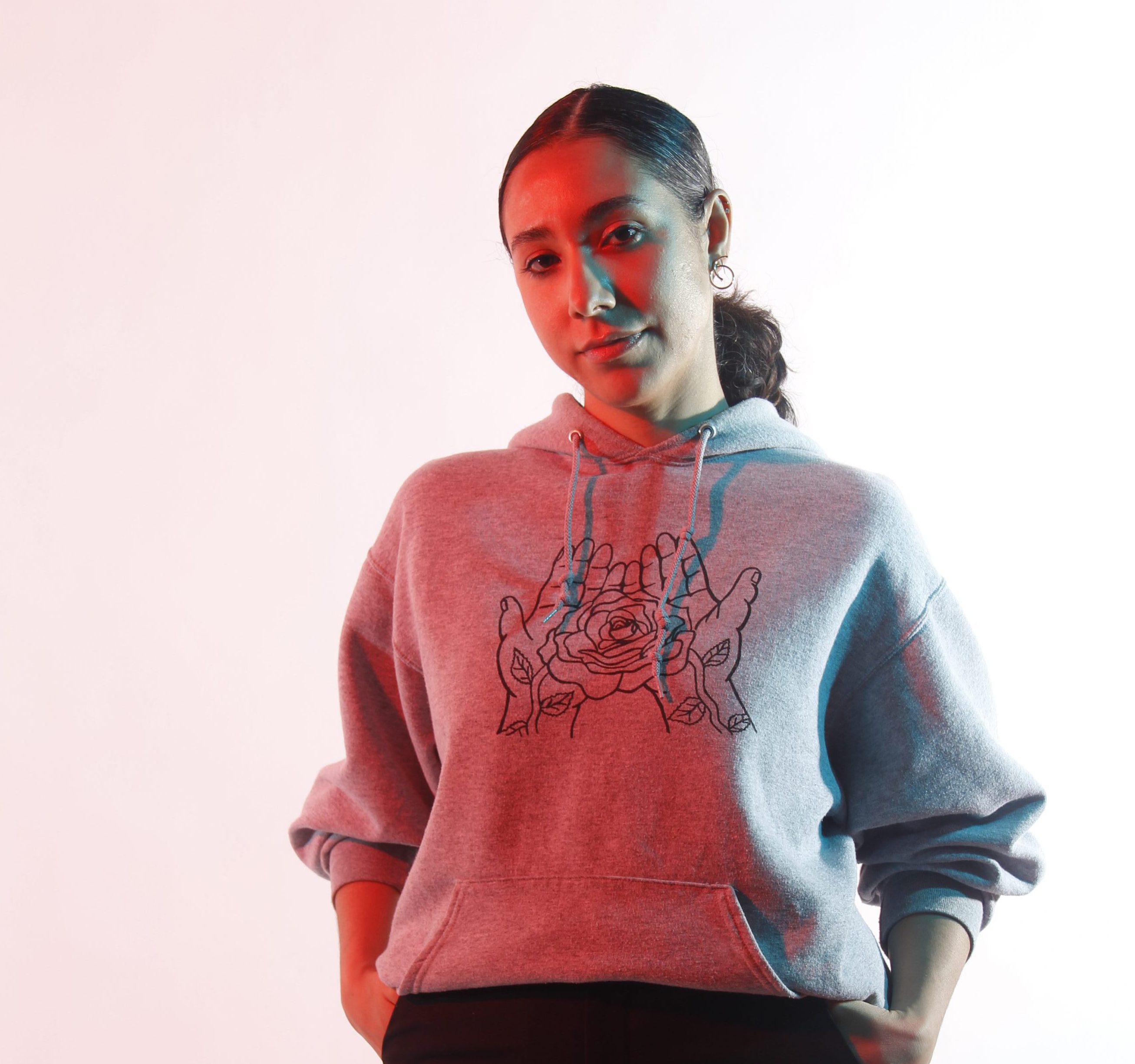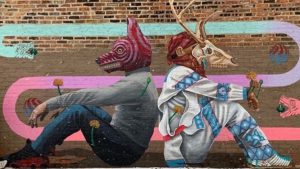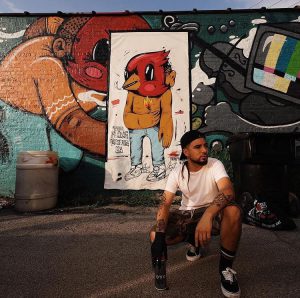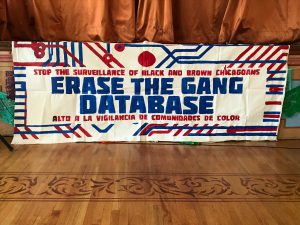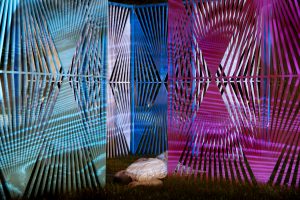Tucked away on the second floor of the Boys & Girls Club on 28th & Ridgeway in Little Village is Yollocalli Arts Reach, a dynamic program that has been providing free visual, digital and media arts programming to young aspiring creators since 1997. In 2012, Yollocalli made Little Village home, and has a second studio location through a partnership with the Chicago Park District at Barrett Park in Pilsen that serves as an artist in residency space and provides free workshops. I caught up with Programs Coordinator Hananne Hanafi in YolloCalli’s vibrant space to learn more about the ways she and her colleagues are empowering creative youth in Little Village to express themselves through art.
Anjali Misra: How did you all end up in this particular space and this particular community?
Hananne Hanafi: The National Museum [of Mexican Art] started the program and originally the space was located in Pilsen, and it was on the corner, it’s where the Giordano’s is now at 18th and Blue Island. So it was there for years and then from there moved into here because that space was bought out. The museum had to sell it. This space it used to be Radio Arte. It just worked out as a partnership where we’re using this second floor of the Boys & Girls Club. And we just run the programs out of here.
AM: How did you become involved?
HH: So I am actually fairly new. I started October of 2016. But I’m not new to the neighborhood or to the work. I’ve been in Little Village and doing arts organizing and programming for over 10 years. I started in schools and transitioned into more arts based programming and that’s how I ended up at Yollo. But I was always familiar with the organization and obviously the [National Museum of Mexican Art]. I’ve just always been a big fan of Yollo and the work that they do here. Someone told me about the job opportunity when the opening was available and it just happened. The youth council actually interviewed me, the teens have a big role being the deciding factor in a lot of things. Like during our events they plan and organize all that. They help hire instructors and decide on just everything really. So when the position was open. the kids interviewed me. At the time I was living in Madrid and so we did a Skype interview. And it was so awkward my internet reception was terrible. So now we joke all the time how crazy was that, like, the Skype interview and yet here I am. But yeah it was a fun experience because they did the interviews and then brought me on board.
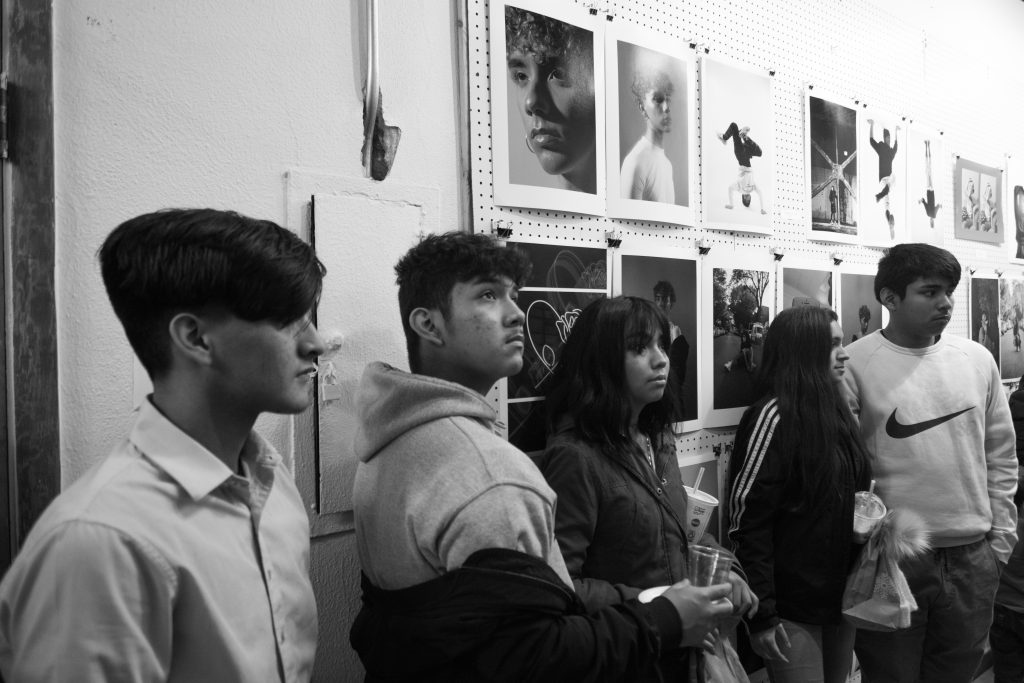
AM: Are you from Chicago?
HH: I’m from Chicago, yes. Born and raised.
AM: Can you talk about the kind of programming you work on?
HH: So we run sessions here in this space. We have several spaces actually. So here at the YolloCalli space in Little Village we run the radio program, it’s called Your Story Your Way. It’s a radio and audio production class. And then we also have the camera flux class, which is more photography and video. And then the Street Art Studio class which is in that other side and they’re more in visual arts, painting. They do a lot of mural concepts and implementation. They go out and paint the murals. And sticker designs and they learn the history of graffiti and all that. And then the camera class is really cool because they’re able to really do studio photography but also they learn the DSLR cameras and the manual options and things like that. And they actually go out to photograph and do more of like, documentary photography but also studio photography. They learn the whole setup, software, editing software — they do video. So it’s just all-encompassing.
But aside from this space, we also have the space in Barrett Park, which the museum has had for as long as I think YolloCalli has been around. It was one of the spaces that was also part of the YolloCalli program and so that space is where we have our artist in residency program. And then aside from that, we have some programs at Links High School, which is also here in Little Village. That’s a graffiti mural class and a photo and video class. And then I didn’t mention that we have another program here which is new and it’s called La Mesita which is kind of a take on NPR’s tiny desk. And they really focus on inviting different musicians from around the city, mainly from Little Village. The goal is for it to be more like Little Village-based musicians and young people. And they record them live, performing live and then do an interview style. And it’s all live-casted onto our Facebook. And then aside from that we throw a ton of events.
AM: Working in this neighborhood, what needs emerge for participants? What comes up for them in either the projects that the young people are working on, or the art they’re producing?
HH: I think what comes up a lot is their personal experiences. We do serve a lot of teens that are from Little Village, but we do get teens from different areas of Chicago. So some that go to school together, some that don’t. And so I think a lot of the work is just their human connections just like having this space outside of their school, where they can get together. I think that in itself means a lot to them to have a space that they know they can go to where it’s not a school space. I think they associate school with stuffiness. But when they come here, it’s different. It’s a different vibe for them. So you see a lot of that in their work. They feel more free in expressing themselves maybe in ways that they wouldn’t be able to at home, or with school, or other clubs they can be a part of, like church, or just any other place that they might go to. So I think Yollo in that way serves as something different to them. Like in the paintings that they do or the audio stories that they record or the radio shows they produce, the photos that they take. They have all these opportunities that I don’t know that they would have access to if it wasn’t for the existence of this space.
AM: What is the process for outreach and recruitment? How do young people find YolloCalli?
HH: I think we have built a reputation, you know? For being the arts hub. Like the teen arts hub of the neighborhood. And so a lot of it is just word-of-mouth. We do go to schools and we recruit. But I think most times people just kind of end up here, you know? Like when someone wants to do something [artistic] somehow they seek us out. And so we’ll get emails, or teens that have been part of the program will recommend their friends, or their friends will come and be like “hey, how can I get involved?” A lot of the kids from the downstairs club will kind of wander up here like, “What’s going on up here? How do I get to be a part of it?” I would hate to feel like we have this space, and there’s kids that don’t know about it, you know? Or like, I’d rather they know about it and decide that’s not something they want to do than just kind of to have missed the opportunity.
But mainly I just think it’s word-of-mouth. I think that’s the beauty of it. I think that we’re just so welcoming and we don’t really turn anyone away, ever. That’s what keeps them coming back. It’s just a different vibe in here I think than being somewhere where you’re told that “things can’t be this way, you can’t say that, you can’t express yourself in this way.” We’ll talk to [participants] and they’ll say things like “I just feel so welcome here. I never feel like I have to be anybody but myself,” or “I discovered myself in different ways.”
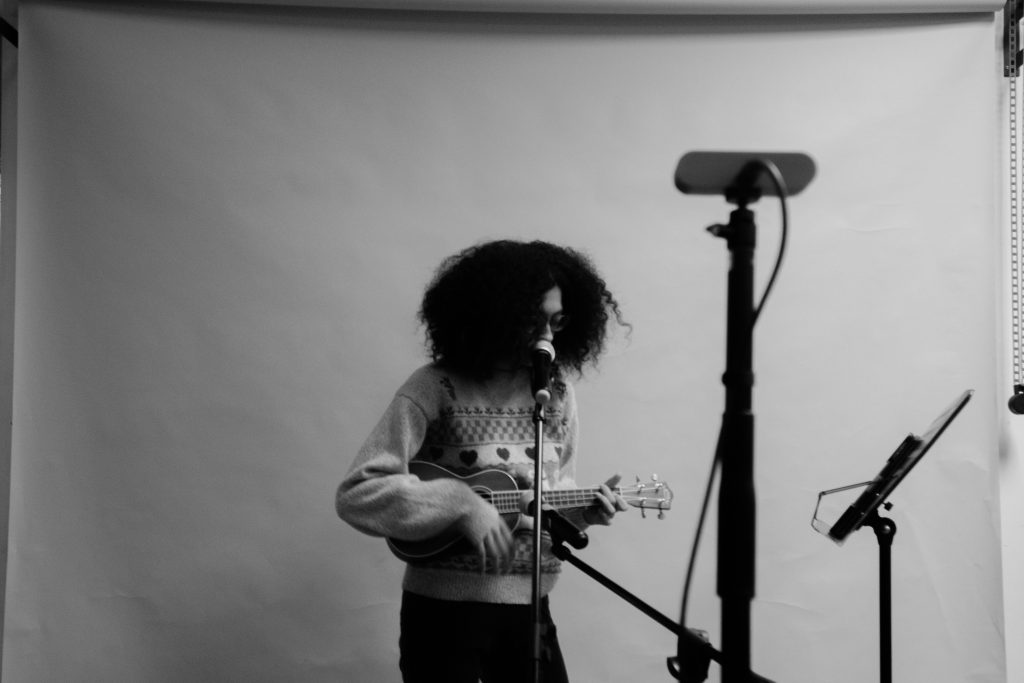
AM: Would you say most of the people who end up staying for programs are students who start out saying, “I’m an artist,” or do they develop into artists here?
HH: I think it’s a good mix. Honestly, I think some kids come just wanting to be a part of whatever’s going on here. It just intrigues them or they’ve been to an event or they’ve seen something that they don’t know what it is, but they want to be a part of it, like “what can I do to get involved?” And then we kind of help them navigate their interests. And all our programs offer stipends, so that’s a big draw for some of the teens. When they come in, it’s like a job for them, a job training program. And so they get to at least get that experience of “I’m an artist and I’m being paid for the work that I do.” And that has worth. That their ideas are worth something. They can learn that. But the programs that we offer, aside from providing a stipend, they’re also free. So I think that alone can be rare. A young person might know they want to do something, but can’t do it because their parents can’t afford to pay for it, and so I think YolloCalli fills that gap where it’s super cool, super advanced programming that is free. We pay you, you get to eat and you get to hang out.
And the teachers are working artists. They are professionals in the fields that they’re teaching. [Participants] get to work with really cool different artists, who, in their own field, have been pretty successful. So [participants] can see that artists come here and teach, but after that you can make a living out of this or it can just be a hobby and that’s fine too. We also try to share opportunities, like the museum will hire gallery attendants. We even have an opportunity over the summer for an advanced internship. And a lot of our interns have gone to work at the museum as museum attendants or just any other opportunities we know of, we kind of try to help lead them into those opportunities.
AM: Given that YolloCalli offers so many opportunities for youth to be in positions of leadership through Youth Council, would you call this a youth-driven organization?
HH: For sure. For example the radio programs are all youth-produced. So the teens come up with ideas for the shows, themes, all of it. It’s kind of a collaboration between them and the instructors. It’s never like “I’m the instructor, I’m going to tell you what you need to do.” It’s more of a brainstorming process with the teens and the instructor and it’s just all their ideas. Just recently they were able to lead a college-level class at Notre Dame. We took three teens who prepared a whole lesson for a college level class. And taught the whole class how to edit audio pieces in GarageBand. And we’ve been collaborating with others like the Jewish Museum in San Francisco. Youth artists submitted creative pieces that they were then able to present in San Francisco.
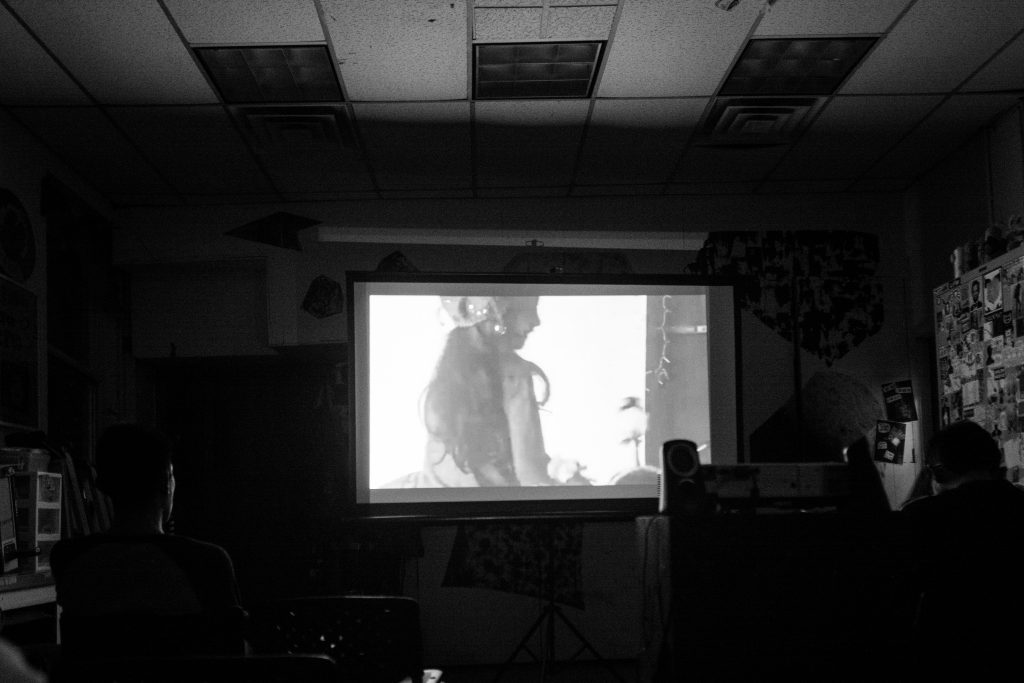
AM: How do you express the importance to the young people of all of the programs being led by them?
HH: I was actually just talking to them [about that] the other day. I go to these meetings often, where I’m in a room with a bunch of adults and the adults are trying to figure out how to do things and it always comes up that we really need to be hearing from the youth what they want. And that’s what we’re creating here [at YolloCalli]. It’s a space where it really is youth-led, youth driven and they’re the ones that tell us what they want, what kind of programs the want or what resources they want or what connections they want to make. So I just told [the participants] that I was at these meetings and that their voice is so needed, and so wanted. But I think just the way things are structured sometimes they don’t know that people are really listening. And so to be heard, sometimes, I think is really meaningful to them. But to be heard and then see that your ideas are being put into action, I think is really meaningful. And that’s when they start to realize “I am making a difference here. I am impacting programming, I am impacting my peers.” I think it is really just about listening to them.
AM: What impact do you think the presence of the programs are having on the neighborhood?
HH: I think we have really solidified our place here in the neighborhood. People reach out to us from different organizations to collaborate, and parents and teens will reach out to us, too. And that really is telling of the impact that we’ve had in the neighborhood. We’re part of collaboratives and collectives that are in the neighborhood, so as much as we can, we’re involved in things that are happening around the neighborhood. And I think this neighborhood has really helped in flourishing that. Another way that the community really connects with YolloCalli is when we put up murals. [Neighbors] come and they talk to the students while they’re painting and ask questions or just admire the work and tell the kids how cool it is. In that way they connect a lot with the neighborhood. The radio show participants have done series of on “Sounds of Little Village,” and “Portraits of Little Village,” so different things that relate to the neighborhood. In that way they were able to go face-to-face and just meet the people that are here every day that they see every day. And they just talked to people. Even the photo students go out and take portraits, which allows them to connect in small ways with the people in the neighborhood.
AM: What hopes do you have for the future of YolloCalli and youth in Little Village?
HH: I think my worry is always that we’re here and people don’t know. So I would never want someone to miss the chance to come and be a part of these programs. Because they were too shy to come in or too nervous to ask. I think that’s why I like when it’s word-of-mouth because their friends are kind of like “Yeah, they’re cool!” or “It’s a good space, come and you’ll learn to do this and you’ll do that!” Or if they’re able to see the work when we have exhibitions. Things like that, I think, help just to bring people through the door. Little Village is definitely a really tight-knit community. I know that there are certain ways it’s portrayed in the media. It has a certain reputation. So I think being able to really highlight and celebrate these spaces that are doing good work and are providing outlets for teens is a way to deter from negativity that surrounds the neighborhood. When you’re here, it’s a different sense of community than what you hear when you’re not around.
Featured image: A photo of Hananne Hanafi standing against a white background with her hands in her pockets. She is wearing a gray hoodie and black pants. There is a soft rose glow to the lighting in the picture. Photo by Yollocalli student Gloria Lopez.
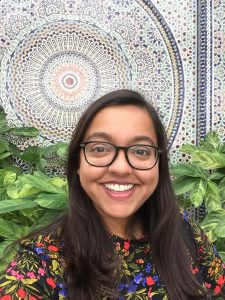 Anjali Misra is a Chicago-based nonprofit professional and freelance writer of media reviews, cultural criticism, and short fiction work. With a background in radio journalism, community theater management, directing and performing, Anjali is passionate about the intersections of art and social change. She earned her bachelor’s in English Lit and a master’s in Gender & Women’s Studies from the University of Wisconsin in Madison, where she had the privilege over the course of nine years to support the work of groups like MEChA, GSAFE, YWCA and Yoni Ki Baat.
Anjali Misra is a Chicago-based nonprofit professional and freelance writer of media reviews, cultural criticism, and short fiction work. With a background in radio journalism, community theater management, directing and performing, Anjali is passionate about the intersections of art and social change. She earned her bachelor’s in English Lit and a master’s in Gender & Women’s Studies from the University of Wisconsin in Madison, where she had the privilege over the course of nine years to support the work of groups like MEChA, GSAFE, YWCA and Yoni Ki Baat.
